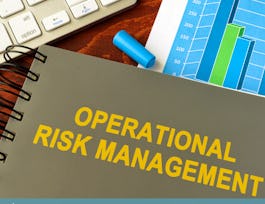In this course, you will learn about risk assessment techniques and how to implement a number of strategies that will ensure the protection of assets. You will learn about the relationship between assets, vulnerabilities, threats, and risks. You will also engage with a number of current case studies in the industry that illustrate the material. You will leave the course with skills relating to threat modeling and business continuity planning that have direct applications at your current job or in your future career.



Introduction to Risk Management
This course is part of Introduction to Cybersecurity & Risk Management Specialization

Instructor: Qasim Ijaz
Sponsored by Abu Dhabi National Oil Company
10,702 already enrolled
(125 reviews)
Details to know

Add to your LinkedIn profile
4 assignments
See how employees at top companies are mastering in-demand skills

Build your subject-matter expertise
- Learn new concepts from industry experts
- Gain a foundational understanding of a subject or tool
- Develop job-relevant skills with hands-on projects
- Earn a shareable career certificate


Earn a career certificate
Add this credential to your LinkedIn profile, resume, or CV
Share it on social media and in your performance review

There are 4 modules in this course
Welcome to the first module of Introduction to Risk Management. In this module we focus on understanding what a risk is and the range of dependencies that a risk may rely on. We will also list and describe risk assessment techniques that can help you better understand any risk landscape. Finally, we will discuss how to present identified risks to your leadership for better decision making.
What's included
4 videos1 reading1 assignment1 peer review
Welcome to Module 2! Now that we have practiced identifying risk, we will discuss the means to manage it. In this module you will be introduced to the three categories of controls, as well as the six steps of the Risk Management Framework (RMF).
What's included
3 videos1 reading1 assignment1 peer review
Welcome to Module 3! This week, we discuss the art of threat modeling. Being able to threat model is an important skill for security professionals, as well as other professions within the computing realm. Threat modeling can help with early identification of security issues, make the organization more efficient, and offer a better understanding of how prone the organization and its assets are to attacks.
What's included
4 videos1 reading1 assignment1 peer review
Welcome to the fourth and final module of Introduction to Risk Management! Information systems play critical role in today's business, hence it's important to have a continuity plan for information systems, as well as your other business functions. A business continuity plan enables business and its IT infrastructure to withstand any likely disruptions. Whether you're working towards a CISSP certification or a role in risk management, it is very important to understand the role business continuity plays in continuation of critical business operations.
What's included
5 videos1 reading1 assignment1 peer review
Instructor

Offered by
Why people choose Coursera for their career




Learner reviews
125 reviews
- 5 stars
78.57%
- 4 stars
15.07%
- 3 stars
3.96%
- 2 stars
0.79%
- 1 star
1.58%
Showing 3 of 125
Reviewed on Sep 30, 2021
I have never thought about cybersecurity and how it works. This is very interesting to learn something I never knew.
Reviewed on Jun 13, 2021
VERY INFORMATIVE AND RELEVANT TO CURRENT ECONOMIC ENVIRONMENT
Reviewed on Aug 29, 2023
This was a great foundational class on the roles that security personnel play in risk management.
Recommended if you're interested in Computer Science

Open new doors with Coursera Plus
Unlimited access to 10,000+ world-class courses, hands-on projects, and job-ready certificate programs - all included in your subscription
Advance your career with an online degree
Earn a degree from world-class universities - 100% online
Join over 3,400 global companies that choose Coursera for Business
Upskill your employees to excel in the digital economy






